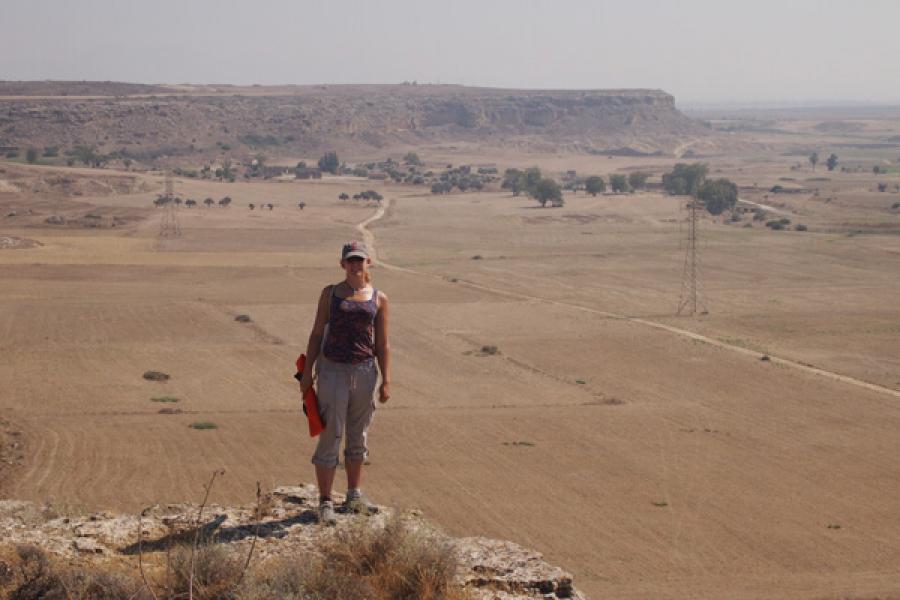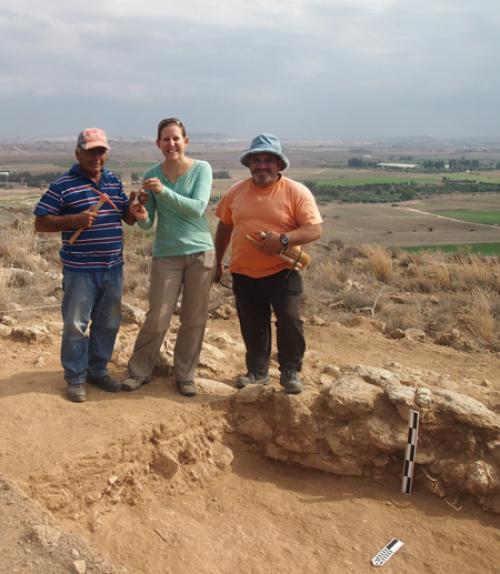In the ancient ruins of Cyprus, archaeology doctoral student Eilis Monahan hopes to uncover some clues about how social inequality might have begun.
As a Fulbright- and National Science Foundation-funded scholar, Monahan will be spending nine months on the island this fall working with the Department of Antiquities of the Republic of Cyprus to survey archaeological sites of its fortresses and prehistoric villages as part of the Ayios Sozomenos Excavation and Survey Project, directed by Dr. Despina Pilides. The data that they collect will be used to explore to learn how a relatively egalitarian village society during the Early to Middle Bronze Age (roughly 2500 to 1650 BC), rapidly changed to one of extreme social inequality and political complexity in the Late Bronze Age (ca. 1650 to 1050 BC). The key, she believes, may be in the construction of fortifications, the physical embodiment of large scale violence.
“I’m interested in the way the built environment controls the way we can move and affects our social interactions,” said Monahan, who received her undergrad degree in classical and near eastern archaeology from Bryn Mawr College. “The material world actually creates social inequality by making our differences concrete. Objects, buildings, these things that surround our lives, provide opportunities and limitations on our actions. Because these things are real and in the world outside our own existence, their effects can be long-lived and unpredictable.”
As an island, Cyprus offers a unique opportunity for study because of both its isolation from other communities, as well as its central location between the Aegean, Anatolia, the Levant, and other trading partners, who sought connections to the island because of its supply of copper, Monahan said.
“The ancient Cypriots were in a really special situation: they had something [copper] that everyone wanted, but by being on an island they had more control over their interactions with the other powerful states and empires of the time,” she said.
Thanks to the support of the Cyprus Department of Antiquities and Pilides, Monahan will have the opportunity to supervise the project’s resurvey of 23 sites in the central region of Cyprus, originally marked on an archaeological survey map from the 1950s. Some of these are buried settlements, while others are standing remains of fortresses on high elevations.
She’ll do the majority of her field work after fields have been plowed but when crops have either been harvested, or are not yet planted or are still small. Timing for this kind of work is essential. Under the right conditions, surface artifacts are more visible. Monahan can analyze what she finds to determine various characteristics of the site like size, density of activity, and time period.
“If we find fragments of cookpots, we know that’s probably a house, because you wouldn’t bring your cookpots out into the field with you, but if we find lots of storage vessels, for example, we can classify that as some sort of industrial site,” she said. “I’ve spent the last seven years staring at various kinds of Cypriot pottery, so a lot of my work will be using the pottery to assess the sites.”
Monahan will also use some of her research funding to support the use of ground-penetrating radar and magnetometry equipment, which uses physical properties of soil and architecture, as well as multi-spectral satellite imagery to aid in seeing beneath the surface and help determine the nature of the architecture inside some of the fortresses.
From her past work in Cyprus and excavations and research by other archaeologists, Monahan thinks she will find that a number of settlements were suddenly abandoned and moved closer to the four fortresses, either for protection or because of pressure from community leaders.
Along with the movement toward fortresses, Monahan said the period is marked by increased violence, which archaeologists recognize because of the increased presence of weapons in tombs and burial sites.
She said that this unrest and violence during the Middle Bronze Age on Cyprus has been downplayed by archaeologists, but it may be much more significant. The emergence of fortresses indicates that people found something to be fearful about, whether that was each other or an enemy from abroad.
“The question then becomes, how does the presence of these buildings and objects change the way society behaves?” she said.
“Most of the fortresses on Cyprus are in the occupied territory in northern Cyprus (controlled by Turkey), but there’s this one cluster that is in the Republic where you can access them,” she said of her research sites.
One of the fortresses was excavated in 1924, so part of Monahan’s work will be to track down and reanalyze the objects from that excavation. Last fall, under the direction of Dr. Pilides, she supervised test excavations at two of the other sites and found huge walls and a trove of new pottery that helped to more accurately date the sites, helping to confirm that the fortresses could be more important than previous research suggested.
Monahan came to Cornell after working for several years in the retail and video game industries out west, when she happened to meet someone who noticed her archaeology background and offered her a job at working for the Mashantucket Pequot Tribal Nation, conducting excavations for clients wanting to build on potentially sensitive sites in New England. She later went on to do more contract archaeology work in Colorado, Wyoming, and Utah, subcontracted to large engineering firms.
While spending more than two years doing everything from recording 1930s cowboy campsites to excavating paleolithic 8500 BC villages, she found her calling but realized she would need an advanced degree to move forward, so she applied to Cornell, where she knew she could combine her interest in archaeology with other interests in anthropology, computer science and other areas.
“Archaeology can, and sometimes does, combine the study of history, art history, politics, economics, languages, geography, chemistry, physics, geology, and so on,” she said. “Archaeologists pull from any perspective that might help us better understand where we as humans have been, where we are now and where we might be heading.”





